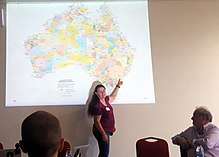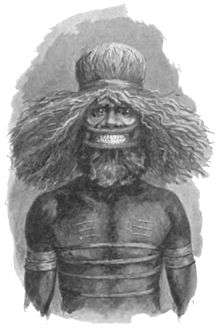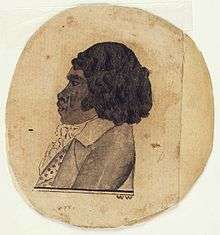Dharug language
The Sydney language, also referred to as Darug or Iyora (Eora) in English, is an Australian Aboriginal language of the Yuin–Kuric group that was traditionally spoken in the region of Sydney, New South Wales. It is the traditional language of the Darug and Eora peoples. The Darug population was greatly diminished since the onset of colonisation.[3]
| Darug | |
|---|---|
| Sydney | |
| Iyora | |
| Region | New South Wales |
| Ethnicity | Darug, Eora (Yura) (Cadigal, Wangal, Cammeraygal, Wallumettagal, ?Bidjigal) |
| Extinct | Late 19th / early 20th century |
| Revival | Small number of L2 speakers |
Pama–Nyungan
| |
| Dialects |
|
| Language codes | |
| ISO 639-3 | xdk |
| Glottolog | sydn1236[1] |
| AIATSIS[2] | S64 |
During the 1990s and the new millennium some descendants of the Darug clans in Western Sydney have been making considerable efforts to revive Dharug as a spoken language. Today some modern Dharug speakers have given speeches in the Dharug language and younger members of the community visit schools and give demonstrations of spoken Dharug.[4]
Bowern (2011) lists Dharuk and Iyora as separate languages.
Name
The speakers did not use a specific name for their language prior to settlement by the First Fleet. The coastal dialect has been referred to as Iyora (also spelt Iora, Eora), which simply means "people", while the inland dialect has been referred to as Dharug (also spelt Darug, Dharuk, Dharruk), a term of unknown origin or meaning. Both names are also used to refer to all dialects of the language collectively.[5]
The term Dharug, which can also be spelt Darug, Dharukk, Dharoog, Dharrag, and Dararrug, etc., came from the word for yam: midyini. Dharug is the root, or the midyini, of the languages of the Sydney basin.
History
Historical area
Their traditional territory spreads from the Georges River and Botany Bay in the south, to Port Jackson, north to Pittwater at the mouth of the Hawkesbury River, and west along the river to Parramatta.
Eora people
The indigenous people identify themselves as Eora, literally meaning "the people", a word derived from Ee (yes) and ora (here, or this place). The language of the people is also called Eora. With a traditional heritage spanning thousands of years, approximately 70 per cent of the Eora people died out during the nineteenth century as a result of smallpox, other pathogens and viruses, and the destruction of their natural food sources.
Earliest habitation
Radiocarbon dating suggests human activity occurred in and around Sydney for at least 30,000 years, in the Upper Paleolithic period.[6][7] However, numerous Aboriginal stone tools found in Sydney's far western suburbs gravel sediments were dated to be from 45,000 to 50,000 years BP, which would mean that humans could have been in the region earlier than thought.[8][9]
First European records
Darug people recognise Sir William Dawes of the First Fleet and flagship, the Sirius, as the first to record the original traditional tongue of the elder people of Sydney Darugule-wayaun.[10][11] Dawes was returned to England in December 1791, after disagreements with Governor Phillip on, among other things, the punitive expedition launched following the wounding of the Government gamekeeper,[12] allegedly by Pemulwuy, an Yora man.
Current state
The language has largely been lost, largely due to the historical effects of colonisaton on the Darug people. Some vocabulary is retained by some Darug people, but only very little grammar. A recreated version of the language is spoken at welcome ceremonies conducted by the Darug people.[13]
Phonology
Consonants
| Peripheral | Laminal | Apical | ||||
|---|---|---|---|---|---|---|
| Bilabial | Velar | Palatal | Dental | Alveolar | Retroflex | |
| Stop | b | k | c | t̪ | t | |
| Nasal | m | ŋ | ɲ | n̪ | n | |
| Lateral | ʎ | l | ||||
| Rhotic | r | ɻ | ||||
| Semivowel | w | j | ||||
Vowels
| Front | Back | |
|---|---|---|
| High | i | u |
| Low | a | |
The language may have had a distinction of vowel length, but this is difficult to determine from the extant data.[14]
Words borrowed into English
Examples of Dharug words that have been borrowed into English are:
- Names of animals: dingo, koala, wallaby and wombat
- Trees and plants: burrawang, kurrajong, geebung, myall and waratah
- The tools boomerang, a word from the Turuwal sub-group, and woomera (spear-thrower)[15]
- The word gin, a now derogatory term for an indigenous woman, is believed to derive from Dharug diyin, "woman"[16][17][18]
- The word koradji, referring to an Aboriginal person with traditional skills in medicine, comes from Dharug.[19]
Revival


Although Dharug is classified as extinct, there is a small number of descendants of the Darug nations who still speak it and efforts have been made to revive the language. As of 2005, some children at Chifley College's Dunheved campus in Sydney had started learning the reconstructed Dharug language,[20][21] and parts of the language have been taught at the Sydney Festival.[22]
Notes
- Hammarström, Harald; Forkel, Robert; Haspelmath, Martin, eds. (2017). "Sydney". Glottolog 3.0. Jena, Germany: Max Planck Institute for the Science of Human History.
- S64 Darug at the Australian Indigenous Languages Database, Australian Institute of Aboriginal and Torres Strait Islander Studies
- Troy (1994): p. 5.
- "Dharug Dalang". CITIES. Retrieved 21 September 2010.
- Troy (1994): p. 9.
- Macey 2007.
- Barani 2013.
- Attenbrow 2010a, pp. 152–153.
- Stockton & Nanson 2004, pp. 59–60.
- "The notebooks of William Dawes". School of Oriental and African Studies and NSW Department of Aboriginal Affairs. Retrieved 21 September 2010.
- Troy, Jakelin. "The Sydney Language Notebooks and responses to language contact in early colonial NSW" (PDF). Australian Journal of Linguistics. 12: 145–170. doi:10.1080/07268609208599474.
- "Dawes, William (1762 - 1836)". Australian Dictionary of Biography Online. Retrieved 16 September 2010.
- Everett, Kristina. "Welcome to country ... not." Oceania, vol. 79, no. 1, 2009, p. 59. Religion and Philosophy Collection, http://link.galegroup.com.ezp.lib.unimelb.edu.au/apps/doc/A197926855/PPRP?u=unimelb&sid=PPRP&xid=1ed530cc. Accessed 24 Aug. 2018.
- Troy (1994): p. 24.
- boomerang.org.au; see under "The Origin of Boomerang". Retrieved 16 January 2008.
- PETERS, PAM (26 April 2007). "The Cambridge Guide to Australian English Usage". Cambridge University Press – via Google Books.
- Dalzell, Tom; Victor, Terry (26 June 2015). "The New Partridge Dictionary of Slang and Unconventional English". Routledge – via Google Books.
- Dalzell, Tom; Victor, Terry (27 November 2014). "The Concise New Partridge Dictionary of Slang and Unconventional English". Routledge – via Google Books.
- Oxford Dictionary of English, 3rd ed., p 977.
- "Lost Aboriginal language revived". 14 April 2009. Retrieved 5 June 2018.
- "The first time I spoke in my own language I broke down and wept". The University of Sydney. Retrieved 5 June 2018.
- Ding, Ann (28 December 2017). "Sydney Festival's Bayala: How we all speak some Darug". The Sydney Morning Herald.
References
- Troy, Jakelin (1994). The Sydney Language. Canberra: Panther. ISBN 0-646-11015-2.
- Broome, Richard (2001). Aboriginal Australians. Sydney: Allen & Unwin. ISBN 1-86508-755-6.
External links
- The Aboriginal language of Sydney (with audio sample)
- Jeremy Steele's partial reconstruction of the Sydney language
- Bibliography of Dharug people and language resources, at the Australian Institute of Aboriginal and Torres Strait Islander Studies
- Bibliography of Eora people and language resources, at the Australian Institute of Aboriginal and Torres Strait Islander Studies
